Wen | Liu Yi

At a Nazi rally in Nuremberg in 1935, the front row was left-to-right: Martin Baumann, Rudolf Hess, Hitler, William Bruckner (
As early as 1934, when he first began his permanent residence in Berlin, Hitler's close associates left a prominent impression on Scheyler: although as the Nazi Party seized power, some intellectuals and young university students who aspired to get ahead began to fall to them, the backbone of the party was still composed of people from the urban middle and lower classes, with mediocre intellect, and obvious anti-social tendencies. Unable to find a place in the poor economic situation and cramped political landscape of the Weimar Republic, they enthusiastically threw themselves into the cause of subverting parliamentary politics.
The same is true of Martin Bowman. Born in 1900, he was about 10 years younger than Hitler, Goering, and others, so he could not catch up with the establishment of merit in World War I. In fact, it was not until June 1918, on the eve of the end of the war, that the son of a post office worker in Saxony-Anhalt enlisted as a field gunner, and was soon demobilized with defeat. Like many veterans of the day, Bowman believed in the legend of a "knife in the back" and was closely associated with anti-Semitic groups and the paramilitary group Freikorps. But his main job was to work as an accountant: first in the real estate business on a large farm in Mecklenburg, and then as the treasurer of the famous Free Army unit "Rothbbach Brigade". There he met Rudolf Hus, a year younger than himself, the future commander of Auschwitz.
William Keitel, Hermann Goering, Adolf Hitler, and Martin Baumann (left to right) july 20, 1944
In early 1923, France sent troops to occupy the Ruhr industrial area under the pretext that the German government had delayed paying the reparations for defeat, and the "Freedom Army" immediately threw itself into sabotage against the occupying forces. In May of that year, Huss's close friend and Nazi party member Schlagert was arrested and shot by the French army while sabotaging a train, and rumors spread that he had been betrayed by Walter Cardoff, a former elementary school teacher in Baumann's past, who was in his seventies. So on 31 May, Baumann, Huss, and several accomplices tricked the unarmed Carddorf into a forest outside Mecklenburg, beat him up, and killed him with a bayonet in the throat. The murder was not difficult to detect: an anti-water accomplice confessed to Huss and Bauman, who were quickly arrested and sentenced to 10 years in prison (actually only 4 years in prison) and 1 year in prison. After his release in 1925, Baumann continued to work in Mecklenburg for a year before moving to Thuringia as a self-taught insurance clerk.
Ironically, although Schlagett, whom Baumann "avenged," and huss, a co-defendant, were all fake Nazi Party "veterans" (referring to members who joined the party before the 1930 election), he himself only briefly joined the Nazi peripheral military organizations until 1927, ranking No. 60508. After Bowman entered the room, Himmler specially produced a fake SS document numbered 555 for him to prove that he was senior enough. But Baumann had his own unique way of getting to power: in 1928 he moved to Munich and became an insurance manager for the Nazi Sa. The Nazi Party, which was in the opposition at the time, often sent stormtroopers to hold street demonstrations and clashed with left-wing trade unionists and communists, often resulting in numerous casualties. Bauman's job was to help the families of these casualties apply to insurance companies for compensation and ensure that the families of the "martyrs" received the necessary compensation. By 1930, since most insurance companies had refused to accept applications for SA, Baumann simply launched a "Nazi Party Relief Fund", requiring each party member to pay regular contributions to the provident fund, which he himself was responsible for, and the compensation for casualties of SA was paid out of this fund. By 1934, the bailout fund had raised more than 3 million marks in cash each year. Many of the families of the "veterans" who received the reparations were grateful to Bowman, praising the fat man with a big belly as a benevolent and outstanding financial expert who cared for grassroots party members.
Bowman
Of course, Bowman is equally keen to take the upper route. In 1929, he married Gerda, daughter of Walter Buch, a Nazi party elder and chairman of the Party's Arbitration Committee, and met for the first time at his wedding with Hitler, the party's head and vice president, and Rudolf Hess. Four years later, this long-term investment paid off spectacularly: Hitler, who had just come to power, appointed Baumann as Hess's chief of staff and personal secretary, ranking among the 22 national party leaders (Reichsleiter) at the party level after the Führer himself, and at the administrative level comparable to the ministers. He then entered the Reichstag and became a member of Hitler's highest circle of decision-making. More importantly, Bowman soon discovered the weakness of his immediate superior, Hess, and began to quietly usurp the power belonging to the latter, eventually turning Hess into a puppet in his own hands.